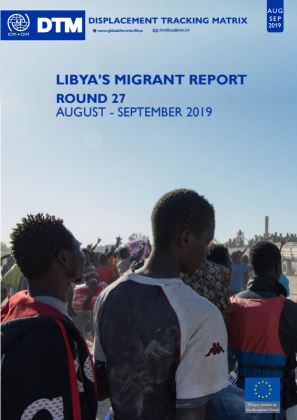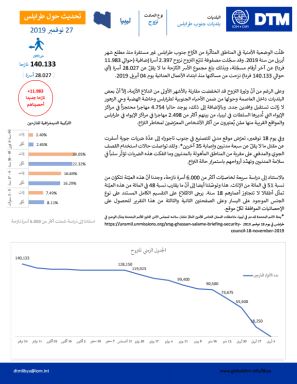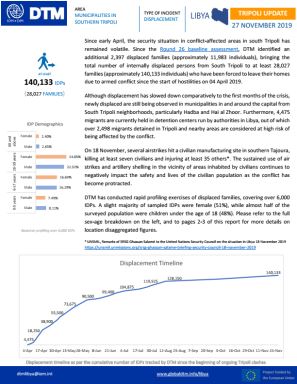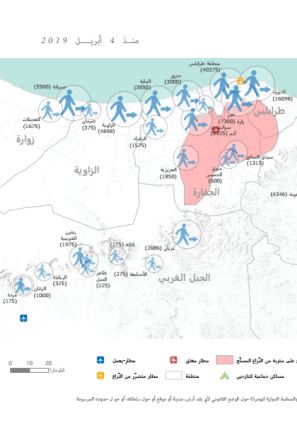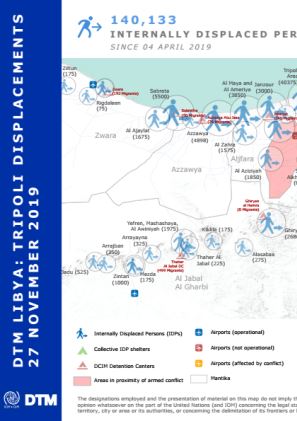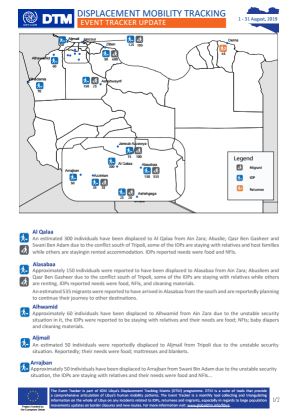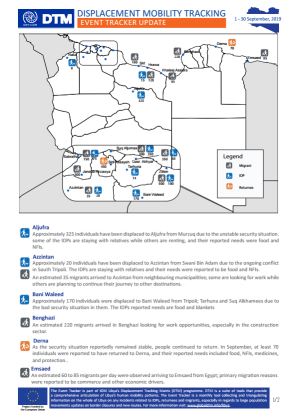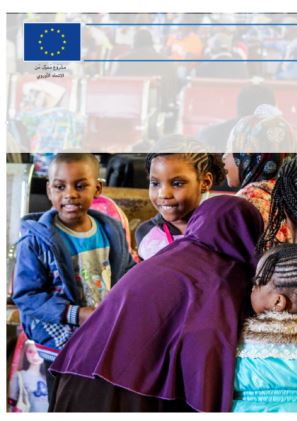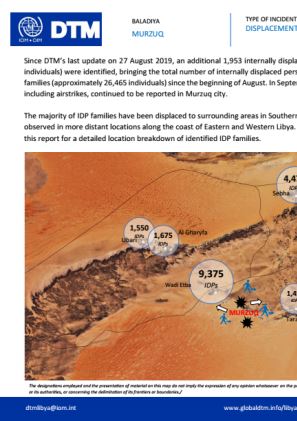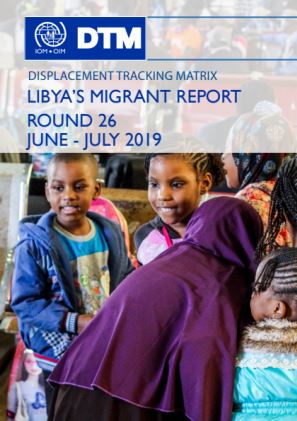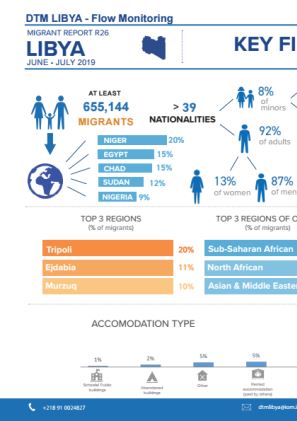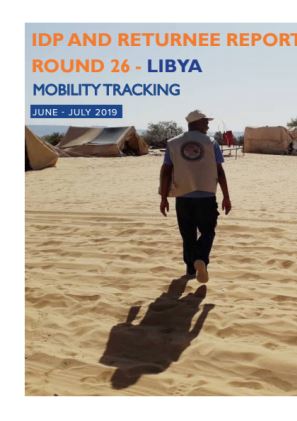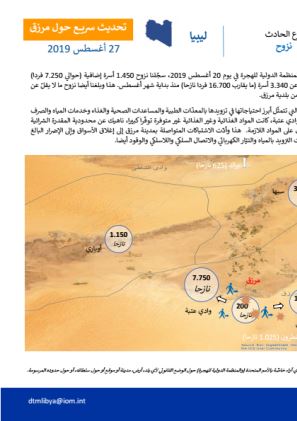-
Countries
-
Data and Analysis
-
Special Focus
-
Crisis Responses
Libya
À propos Libya
Libya is a geographically vast country with several regions that are difficult to access. In order to understand the full scope of humanitarian assistance that is needed throughout the country, IOM established the Displacement Tracking Matrix (DTM) programme in 2016 in order to provide a common operating picture concerning the movement of populations in Libya, allowing humanitarian actors to provide timely assistance to those in need. Following the escalation of conflict and insecurity in 2014, the security situation has remained volatile since with fluctuations in the intensity of localized clashes. Congruently, conflict has caused new displacements, often in areas ill-equipped to accommodate large population movements while also negatively impacting the large migrant population residing and transiting through Libya. More recently, the capital Tripoli was heavily affected by displacement waves in September 2018 and April 2019.
DTM’s mobility tracking and flow monitoring activities identified many migrants in-country to be in need of various forms of assistance. Libya’s geographic location, resources and work opportunities has made it both a country of destination and transit for migrants for many years. Despite the deterioration of the security situation since 2011 migrants continue coming to and transiting through Libya, the majority from Sub-Saharan and North African countries.
In this complex operating environment, DTM Libya has been providing a common operating picture concerning the movement of populations in Libya since 2016, allowing humanitarian actors to provide timely assistance to those in need. Through its mobility tracking, flow monitoring and needs assessment activities, DTM Libya has established itself as data hub for quantitative data on migratory flows to and within Libya, migrant presence in Libya disaggregated by nationality and area, as well as humanitarian needs of migrants, internally displaced population and returnees. All activities are implemented through periodical bi-monthly data collection cycles, allowing trend analysis over time to provide evidence-base for both policy-level discussions and to guide humanitarian action.
In order to facilitate humanitarian interventions, DTM works closely with IOM’s other programmes through referring identified populations in need of assistance at flow monitoring points to IOM’s Direct Assistance, Health, Voluntary Humanitarian Return (VHR), Protection and Migrant Rapid Response Mechanism (MRRM) programmes. Furthermore, DTM Libya supports other humanitarian partners through providing emergency tracking updates in case of sudden population movements as well as facilitating humanitarian assessments for the Rapid Response Mechanism (RRM) jointly implemented by IOM, UNICEF, WFP and UNFPA.
For more information on IOM's activities in Libya, please visit the IOM Libya country office website.
Contacter
DTM Libya
DTMLibya@iom.int
Bailleurs de fonds
- EUTF
Libya — Migrant Report 27 (Aug - Sep 2019) [Arabic]
أجريت الجولة السابعة والعشرين لتجميع البيانات الخاصّة بالهجرة فيما بين شهري أغسطس وسبتمبر من سنة 2019 . وتمكّنت مصفوفة تتبّع النزوح من إحصاء ما لا يقلّ عن 636.426 مهاجرا يعود أصلهم إلى أكثر من 39 دولة مختلفة.
Libya - Migrant Report 27 Key Findings (Aug - Sep 2019)
The 27th round of DTM data collection in Libya took place in August and September 2019. DTM identified at least 636,426 migrants currently present in Libya who originated from more than 39 countries.
Libya — Migrant Report 27 (Aug - Sep 2019)
The 27th round of DTM data collection in Libya took place in August and September 2019. DTM identified at least 636,426 migrants currently present in Libya who originated from more than 39 countries.
Dec 10 2019
Libya — Migrant Report 27 (Aug - Sep 2019)
Libya — Detention Centre Profile Generator (November 2019)
Detention Centre Profiling is a component of IOM Libya’s Displacement Matrix programme.
تحديث سريع حول طرابلس -27 نوفمبر 2019
ظلّت الوضعية الأمنية في المناطق المتأثّرة من النّزاع جنوب طرابلس غير مستقرة منذ مطلع شهر أبريل من سنة 2019.
Nov 28 2019
تحديث سريع حول طرابلس -27 نوفمبر 2019
Tripoli Update (27 November 2019)
Since early April, the security situation in conflict-affected areas in south Tripoli has remained volatile.
Nov 28 2019
Tripoli Update (27 November 2019)
خريطة عدد 16 للنزوح من طرابلس 27 نوفمبر 2019
ظلّت الوضعية الأمنية في المناطق المتأثّرة من النّزاع جنوب طرابلس غير مستقرة منذ مطلع شهر أبريل من سنة 2019.
Nov 28 2019
خريطة عدد 16 للنزوح من طرابلس 27 نوفمبر 2019
Tripoli Displacement Map #16 (27 November 2019)
Since early April, the security situation in conflict-affected areas in south Tripoli has remained volatile.
Nov 28 2019
Tripoli Displacement Map #16 (27 November 2019)
Libya — Displacement Event Tracking Report (1-31 October 2019)
DTM Displacement event tracking in Libya covers all the events related to population movements during one month. In October 2019, events related to displacements and population movements were recorded in 14 Muncipalities (Baladiyas) all over the country.
DTM-WFP: Hunger, displacement and migration in Libya
In Libya, IOM and WFP conducted joint analysis combining face-to-face and web-based interviews. Methodologies used allowed to capture a varied sample of both female and male migrants from various age groups originating from 36 countries.
Libya — Detention Centre Profile Generator (October 2019)
Detention Centre Profiling is a component of IOM Libya’s Displacement Matrix programme. It is a data-oriented tool that routinely provides specific sex and age demographic data and key sectorial information on individuals held in Libya’s detention Centres on the date of assessment.
Libya — Displacement Event Tracking Report (1-31 August 2019)
DTM Displacement event tracking in Libya covers all the events related to population movements during one month. In August 2019, events related to displacements and population movements were recorded in 14 Muncipalities (Baladiyas) all over the country.
Libya — Detention Centre Profile Generator (September 2019)
Detention Centre Profiling is a component of IOM Libya’s Displacement Matrix programme.
Libya — Displacement Event Tracking Report (September 2019)
DTM Displacement event tracking in Libya covers all the events related to population movements during one month. In September 2019, events related to displacements and population movements were recorded in 17 Muncipalities (Baladiyas) all over the country.
Libya — Detention Centre Profile Generator (August 2019)
Detention Centre Profiling is a component of IOM Libya’s Displacement Matrix programme.
Libya — Migrant Report 26 (ARABIC)
The 26th round of DTM data collection in Libya took place between 13 June and 04 August 2019. DTM identified at least 655,144 migrants currently present in Libya who originated from more than 39 countries. Migrants were identified in all 100 municipalities, within 559 communities.
Sep 25 2019
Libya — Migrant Report 26 (ARABIC)
Murzuq Flash Update (21 September 2019) [Arabic]
Since DTM’s last update on 27 August 2019, an additional 1,953 internally displaced families (approximately 9,765 individuals) were identified, bringing the total number of internally displaced persons from Murzuq to at least 5,293 families (approximately 26,465 individuals) since the beginning o
Sep 25 2019
Murzuq Flash Update (21 September 2019) [Arabic]
Murzuq Flash Update (21 September 2019)
Since DTM’s last update on 27 August 2019, an additional 1,953 internally displaced families (approximately 9,765 individuals) were identified, bringing the total number of internally displaced persons from Murzuq to at least 5,293 families (approximately 26,465 individuals) since the beginning o
Sep 22 2019
Murzuq Flash Update (21 September 2019)
Libya — Migrant Report 26 (June - July 2019)
The 26th round of DTM data collection in Libya took place between 13 June and 04 August 2019. DTM identified at least 655,144 migrants currently present in Libya who originated from more than 39 countries. Migrants were identified in all 100 municipalities, within 559 communities.
Sep 13 2019
Libya — Migrant Report 26 (June - July 2019)
Libya - Migrant Report Key Findings 26 (June - July 2019)
The 26th round of DTM data collection in Libya took place between 13 June and 04 August 2019. DTM identified at least 655,144 migrants currently present in Libya who originated from more than 39 countries. Migrants were identified in all 100 municipalities, within 559 communities.
Libya — IDP & Returnee Report, Round 26 (June-July 2019) [Arabic]
This report presents the findings of Round 26 of the mobility tracking component of the Displacement Tracking Matrix (DTM) programme in Libya, covering the reporting period 23 June until 04 August 2019.
Sep 12 2019
Libya — IDP & Returnee Report, Round 26 (June-…
Libya - IDP & Returnee Report Key Findings, Round 26 (June-July 2019)
This report presents the findings of Round 26 of the mobility tracking component of the Displacement Tracking Matrix (DTM) programme in Libya, covering the reporting period 23 June until 04 August 2019.
Sep 12 2019
Libya - IDP & Returnee Report Key Findings, Ro…
Libya — IDP & Returnee Report, Round 26 (June-July 2019)
This report presents the findings of Round 26 of the mobility tracking component of the Displacement Tracking Matrix (DTM) programme in Libya, covering the reporting period 23 June until 04 August 2019.
Sep 12 2019
Libya — IDP & Returnee Report, Round 26 (June-…
Murzuq Flash Update (27 August 2019) [Arabic]
Since DTM’s last update on 20 August 2019, an additional 1,450 internally displaced families (approximately 7,250 individuals) were identified, bringing the total number of internally displaced persons from Murzuq to at least 3,340 families (approximately 16,700 individuals) since the begin
Aug 27 2019
Murzuq Flash Update (27 August 2019) [Arabic]
Pagination
Pagination
- First page
- Previous page
- 1
- 2
- 3
- 4
- 5




